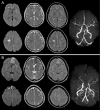Surgical revascularization for quasi-moyamoya disease associated with polyneuropathy, organomegaly, endocrinopathy, monoclonal gammopathy, and skin changes (POEMS) syndrome: a case report and literature review
- PMID: 36923610
- PMCID: PMC10009630
- DOI: 10.18999/nagjms.85.1.141
Surgical revascularization for quasi-moyamoya disease associated with polyneuropathy, organomegaly, endocrinopathy, monoclonal gammopathy, and skin changes (POEMS) syndrome: a case report and literature review
Abstract
POEMS (polyneuropathy, organomegaly, endocrinopathy, monoclonal gammopathy, and skin changes) syndrome is a rare multisystem disease characterized by plasma cell dyscrasia and overproduction of vascular endothelial growth factor, which is related to disease activity. Recent treatment strategies have improved survival of patients suffering from this disorder; however, ischemic stroke remains a poor prognostic factor. POEMS patients with ischemic stroke frequently develop cerebral large artery stenosis/occlusion, followed by progressive stroke. Post literature review, we present an ischemic stroke case of quasi-moyamoya disease linked with this syndrome that was successfully treated with surgical revascularization. A 41-year-old woman diagnosed with POEMS syndrome developed progressive ischemic stroke due to quasi-moyamoya disease, despite decreased vascular endothelial growth factor level with lenalidomide and dexamethasone treatment. She underwent superficial temporal artery to middle cerebral artery bypass with encephalo-duro-myo-synangiosis bilaterally. The postoperative course was uneventful. Two years and five months after the stroke, neuroimaging demonstrated bypass patency, neovascularization after encephalo-duro-myo-synangiosis, and no recurrence of stroke. Our case is the first to report successful surgical revascularization for a POEMS patient. Surgical revascularization may be a useful treatment option for patients with quasi-moyamoya disease associated with POEMS syndrome, especially for those who develop refractory ischemic stroke despite reduced vascular endothelial growth factor level.
Keywords: Crow–Fukase syndrome; STA-MCA anastomosis; cerebral infarction; cerebral revascularization; vascular endothelial growth factor.
Conflict of interest statement
The authors have no conflicts of interest to disclose.
Figures




References
-
- Bardwick PA, Zvaifler NJ, Gill GN, Newman D, Greenway GD, Resnick DL. Plasma cell dyscrasia with polyneuropathy, organomegaly, endocrinopathy, M protein, and skin changes: The POEMS syndrome. Report on two cases and a review of the literature. Medicine (Baltimore). 1980;59(4):311–322. doi:10.1097/00005792-198007000-00006. - DOI - PubMed
Publication types
MeSH terms
Substances
Supplementary concepts
LinkOut - more resources
Full Text Sources
Medical
